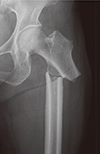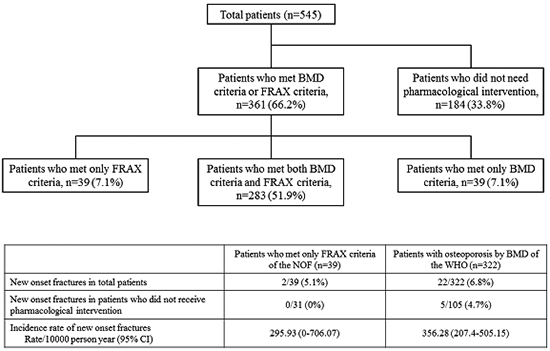1. Sinigaglia L, Nervetti A, Mela Q, Bianchi G, Del Puente A, Di Munno O, Frediani B, Cantatore F, Pellerito R, Bartolone S, et al. A multicenter cross sectional study on bone mineral density in rheumatoid arthritis: Italian Study Group on Bone Mass in Rheumatoid Arthritis. J Rheumatol. 2000; 27:2582–2589.
2. Van Staa TP, Geusens P, Bijlsma JW, Leufkens HG, Cooper C. Clinical assessment of the long-term risk of fracture in patients with rheumatoid arthritis. Arthritis Rheum. 2006; 54:3104–3112.
3. Kim SY, Schneeweiss S, Liu J, Daniel GW, Chang CL, Garneau K, Solomon DH. Risk of osteoporotic fracture in a large population-based cohort of patients with rheumatoid arthritis. Arthritis Res Ther. 2010; 12:R154.
4. Başkan BM, Sivas F, Alemdaroğlu E, Duran S, Ozoran K. Association of bone mineral density and vertebral deformity in patients with rheumatoid arthritis. Rheumatol Int. 2007; 27:579–584.
5. Silverman SL. The clinical consequences of vertebral compression fracture. Bone. 1992; 13:S27–S31.
6. Riggs BL, Melton LJ 3rd. The worldwide problem of osteoporosis: insights afforded by epidemiology. Bone. 1995; 17:505s–511s.
7. Kaz Kaz H, Johnson D, Kerry S, Chinappen U, Tweed K, Patel S. Fall-related risk factors and osteoporosis in women with rheumatoid arthritis. Rheumatology (Oxford). 2004; 43:1267–1271.
8. Smulders E, Schreven C, Weerdesteyn V, van den Hoogen FH, Laan R, Van Lankveld W. Fall incidence and fall risk factors in people with rheumatoid arthritis. Ann Rheum Dis. 2009; 68:1795–1796.
9. Seeman E, Delmas PD. Bone quality: the material and structural basis of bone strength and fragility. N Engl J Med. 2006; 354:2250–2261.
10. Kanis JA, McCloskey EV, Johansson H, Strom O, Borgstrom F, Oden A. National Osteoporosis Guideline Group. Case finding for the management of osteoporosis with FRAX: assessment and intervention thresholds for the UK. Osteoporos Int. 2008; 19:1395–1408.
11. Kanis JA, Johnell O, Oden A, Johansson H, McCloskey E. FRAX and the assessment of fracture probability in men and women from the UK. Osteoporos Int. 2008; 19:385–397.
12. Fujiwara S, Nakamura T, Orimo H, Hosoi T, Gorai I, Oden A, Johansson H, Kanis JA. Development and application of a Japanese model of the WHO fracture risk assessment tool (FRAX). Osteoporos Int. 2008; 19:429–435.
13. Morales-Torres J, Clark P, Delezé-Hinojosa M, Cons-Molina F, Messina OD, Hernández J, Jaller-Raad JJ, Quevedo-Solidoro H, Radominski SC. Fracture risk assessment in Latin America: is Frax an adaptable instrument for the region? Clin Rheumatol. 2010; 29:1085–1091.
14. Yoon J, Kwon SR, Lim MJ, Joo K, Moon CG, Jang J, Park W. A comparison of three different guidelines for osteoporosis treatment in patients with rheumatoid arthritis in Korea. Korean J Intern Med. 2010; 25:436–446.
15. Cheng CK, McDonald-Blumer H, Boire G, Pope JE, Haraoui B, Hitchon CA, Thorne C, Sun Y, Bykerk VP. Care gap in patients with early inflammatory arthritis with a high fracture risk identified using FRAX(®). J Rheumatol. 2010; 37:2221–2225.
16. Furuya T, Hosoi T, Saito S, Inoue E, Taniguchi A, Momohara S, Yamanaka H. Fracture risk assessment and osteoporosis treatment disparities in 3,970 Japanese patients with rheumatoid arthritis. Clin Rheumatol. 2011; 30:1105–1111.
17. Curtis JR, Arora T, Donaldson M, Alarcón GS, Callahan LF, Moreland LW, Bridges SL Jr, Mikuls TR. Skeletal health among African Americans with recent-onset rheumatoid arthritis. Arthritis Rheum. 2009; 61:1379–1386.
18. Baim S, Binkley N, Bilezikian JP, Kendler DL, Hans DB, Lewiecki EM, Silverman S. Official Positions of the International Society for Clinical Densitometry and executive summary of the 2007 ISCD Position Development Conference. J Clin Densitom. 2008; 11:75–91.
19. Dennison E, Eastell R, Fall CH, Kellingray S, Wood PJ, Cooper C. Determinants of bone loss in elderly men and women: a prospective population-based study. Osteoporos Int. 1999; 10:384–391.
20. Seeman E. Clinical review 137: sexual dimorphism in skeletal size, density, and strength. J Clin Endocrinol Metab. 2001; 86:4576–4584.
21. Edelstein SL, Barrett-Connor E. Relation between body size and bone mineral density in elderly men and women. Am J Epidemiol. 1993; 138:160–169.
22. Chapurlat RD, Garnero P, Sornay-Rendu E, Arlot ME, Claustrat B, Delmas PD. Longitudinal study of bone loss in pre- and perimenopausal women: evidence for bone loss in perimenopausal women. Osteoporos Int. 2000; 11:493–498.
23. Haugeberg G, Uhlig T, Falch JA, Halse JI, Kvien TK. Bone mineral density and frequency of osteoporosis in female patients with rheumatoid arthritis: results from 394 patients in the Oslo County Rheumatoid Arthritis register. Arthritis Rheum. 2000; 43:522–530.
24. Korean Ministry of Health and Welfare, Korean Centers for Disease Control and Prevention. National Health and Nutrition Examination Survey 4th 2008. accessed on 20 May 2010. Available at
http://knhanes.cdc.go.kr.
25. Kanis JA, Johansson H, Oden A, McCloskey EV. Guidance for the adjustment of FRAX according to the dose of glucocorticoids. Osteoporos Int. 2011; 22:809–816.
26. Kanis JA, Oden A, Johansson H, Borqström F, Ström O, McCloskey E. FRAX and its applications to clinical practice. Bone. 2009; 44:734–743.
27. Majumdar SR, Morin SN, Lix LM, Leslie WD. Influence of recency and duration of glucocorticoid use on bone mineral density and risk of fractures: population-based cohort study. Osteoporos Int. 2013; 24:2493–2498.
28. Dan LL, Dennis LK, Larry J, Anthony SF, Stephen LH, Joseph L. Harrison's principle of internal medicine. 18 ed. New York: McGraw-Hill;2012.
29. Harris ST, Watts NB, Genant HK, McKeever CD, Hangartner T, Keller M, Chesnut CH 3rd, Brown J, Eriksen EF, Hoseyni MS, et al. Effects of risedronate treatment on vertebral and nonvertebral fractures in women with postmenopausal osteoporosis: a randomized controlled trial: Vertebral Efficacy with Risedronate Therapy (VERT) Study Group. JAMA. 1999; 282:1344–1352.
30. Liberman UA, Weiss SR, Bröll J, Minne HW, Quan H, Bell NH, Rodriguez-Portales J, Downs RW Jr, Dequeker J, Favus M. Effect of oral alendronate on bone mineral density and the incidence of fractures in postmenopausal osteoporosis: the Alendronate Phase III Osteoporosis Treatment Study Group. N Engl J Med. 1995; 333:1437–1443.
31. Ettinger B, Black DM, Mitlak BH, Knickerbocker RK, Nickelsen T, Genant HK, Christiansen C, Delmas PD, Zanchetta JR, Stakkestad J, et al. Reduction of vertebral fracture risk in postmenopausal women with osteoporosis treated with raloxifene: results from a 3-year randomized clinical trial: Multiple Outcomes of Raloxifene Evaluation (MORE) Investigators. JAMA. 1999; 282:637–645.











 PDF
PDF ePub
ePub Citation
Citation Print
Print




 XML Download
XML Download